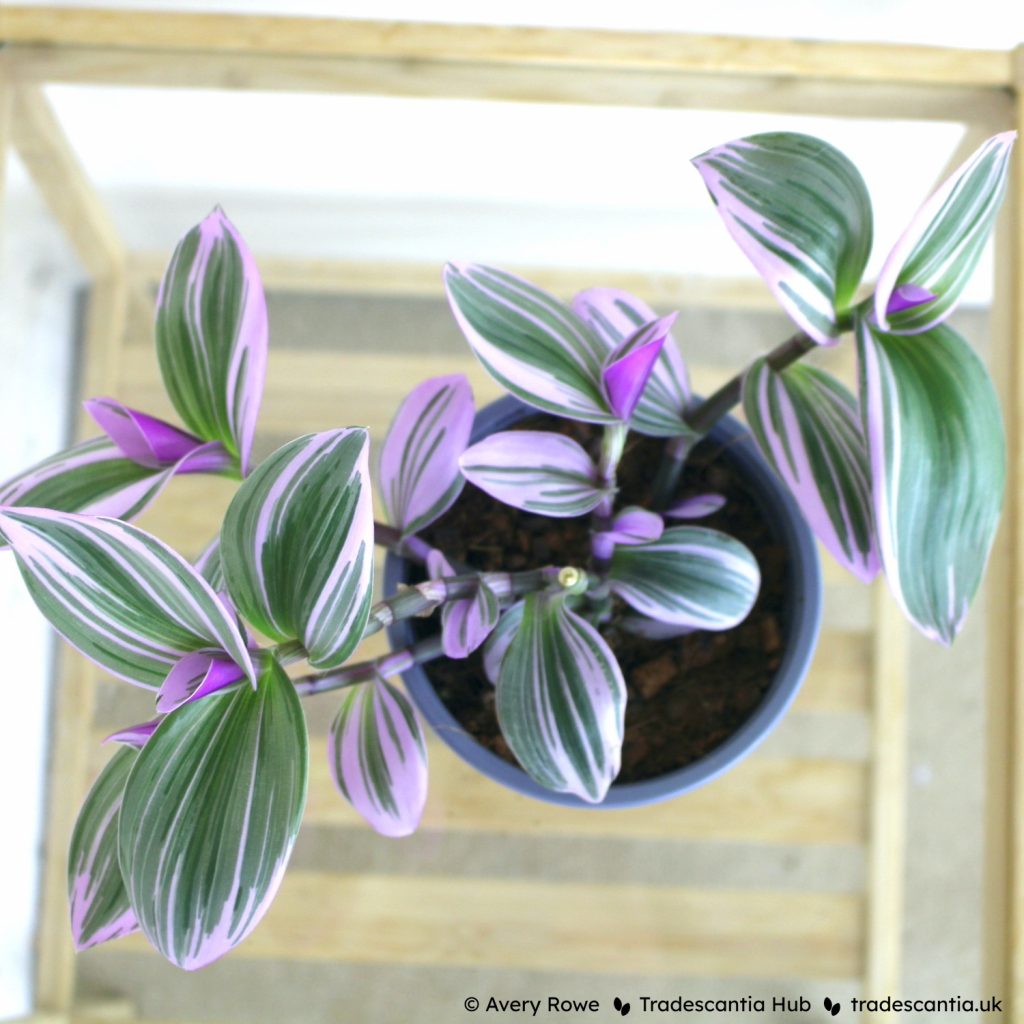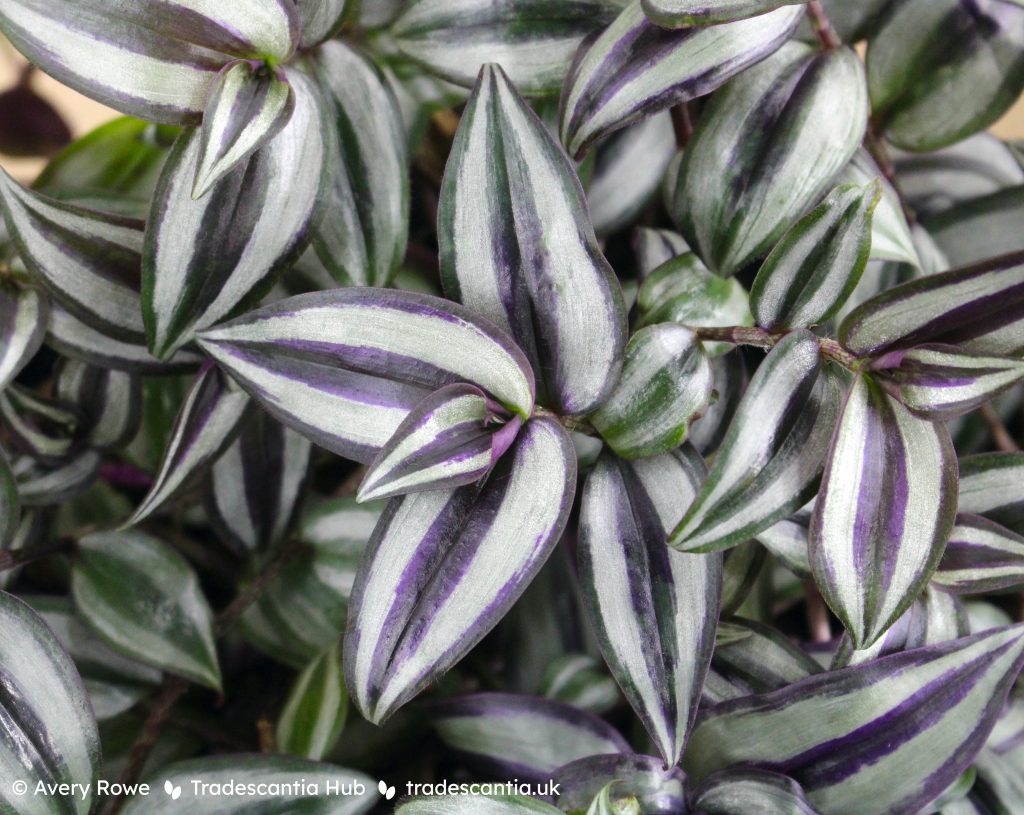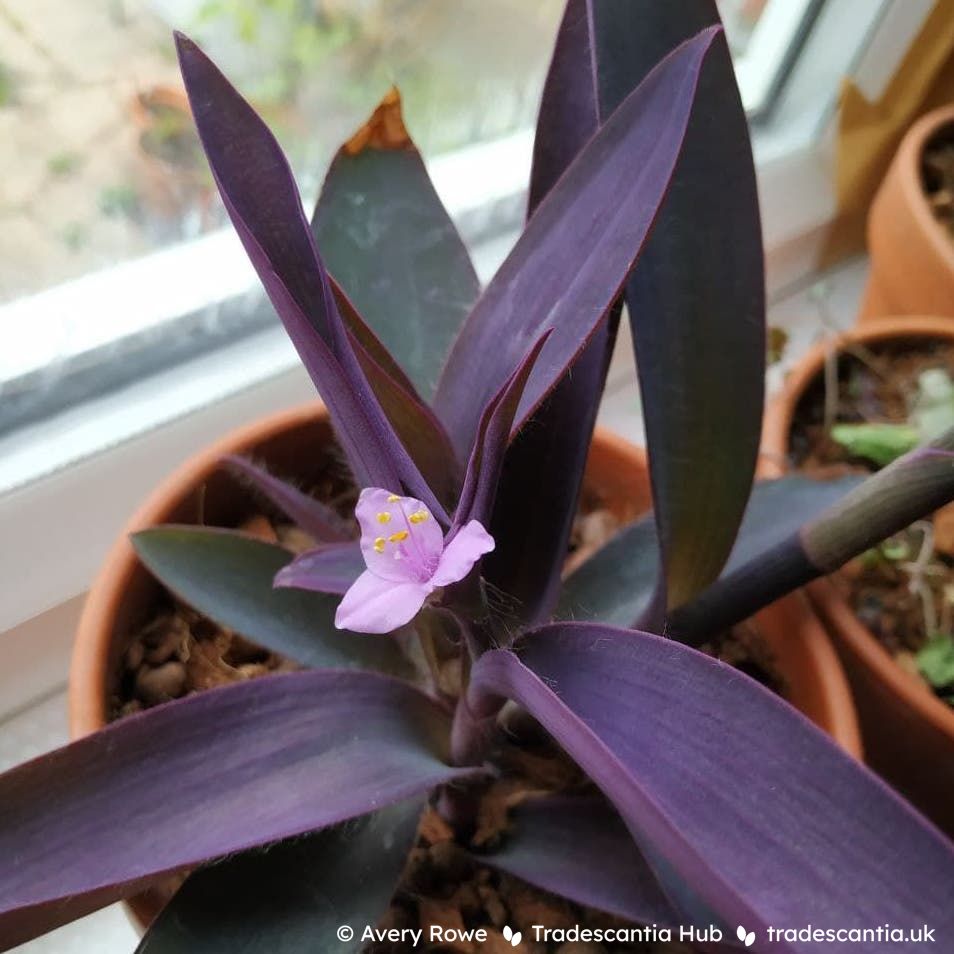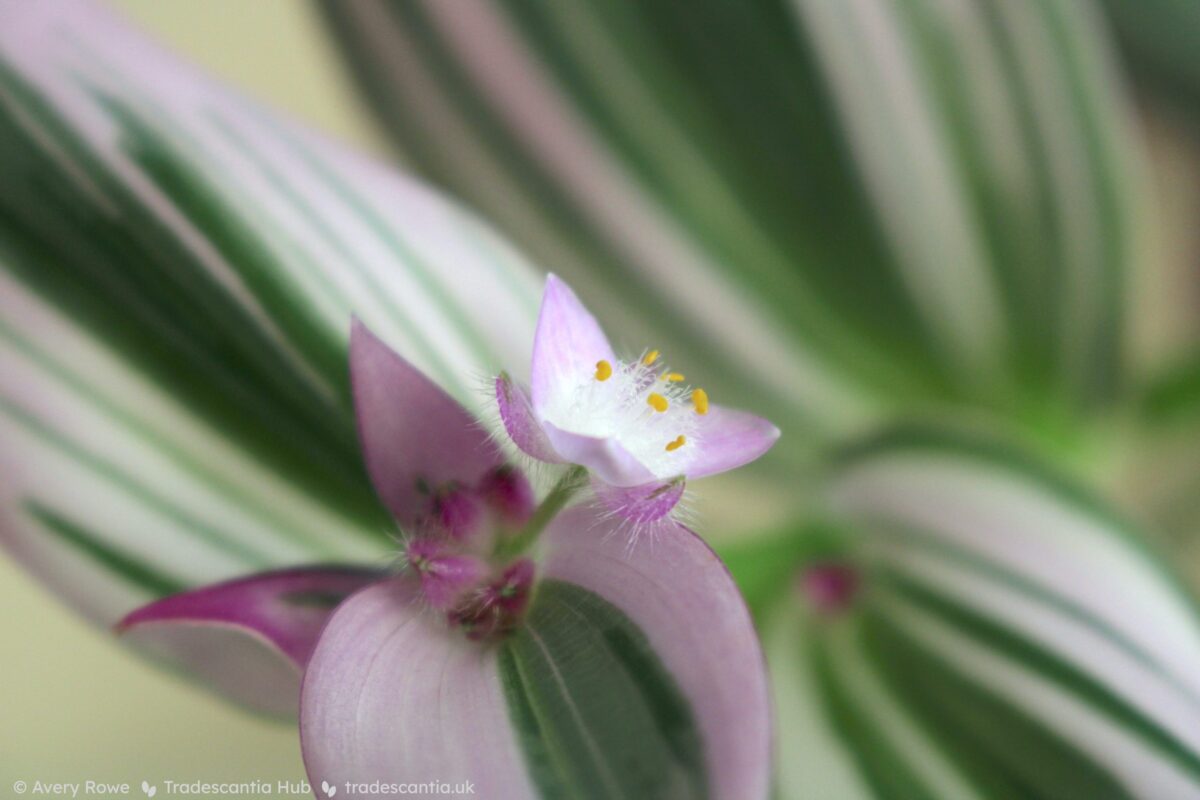Skip to subgenus: Austrotradescantia // Campelia // Mandonia // Setcreasea // Tradescantia // Bibliogrpahy
Tradescantia is a Commelinaceae genus native to the Americas. It consists of herbaceous plants with sprawling or creeping habits, and almost always perennial growth. Most species have somewhat succulent stems and leaves, and they easily form roots at the nodes as they spread. They have simple flowers with three identical petals in shades ranging between white, pink, purple, and blue.
There’s a lot of variation within the genus. The Royal Botanic Gardens, Kew currently recognises 85 species, but the exact count is always changing in line with new research. Historically many species used to be classified in separate genera instead. A recent revision by Pellegrini (2017) organised the genus into five subgenera. This page is a summary of the subgenera and the commonly-cultivated species within them.
Tradescantia subgenus Austrotradescantia

This subgenus is made up of mostly creeping or sprawling plants, native to forests and disturbed areas in South America. All are evergreen perennials, and most have succulent stems and white or pink flowers.
There are about fifteen species, and the subgenus contains several of the most common cultivated houseplant species.
- T. fluminensis (formerly called T. albiflora, and invalidly known as T. repens, among other names) is a delicate green creeper with fairly thin stems, small hairless leaves, and pure white flowers. There are lots of cultivars, with different leaf colours and patterns – ‘Variegata’ is one of the oldest cultivars in the genus. View all cultivars.
- T. mundula is very similar, a small creeper with white flowers – but it’s distinguishable from T. fluminensis by the small hairs covering the leaves. There are only a couple of cultivars, but ‘Lisa’ is among the most widespread tradescantias in commercial cultivation. View all cultivars.
- T. chrysophylla is also very similar, but this time distinguishable by a cover of velvety fur on all surfaces of the leaves and stem. The species was only described scientifically a few years ago, but was in cultivation for some time before that. View all cultivars.
- T. cerinthoides (formerly called T. blossfeldiana) is much larger, with thick succulent stems and tough leaves. Its stems grow more upright to begin with, and it forms pink flowers with a white centre. There are several cultivars, most notably the pink variegated ‘Nanouk’ which arose in only the last ten years and has become wildly popular all over the world. View all cultivars.
- T. crassula is another fairly large and succulent species, with pure white flowers. The species itself is not very common in cultivation, but it’s likely to be an ancestor to a number of hybrid cultivars (below).
- The Tradescantia Continental Group contains a loosely-related set of hybrid cultivars. These cultivars tend to have a compact and branching growth habit, white flowers, and white or pink variegated leaves – although reverted green sports are also common. They are sometimes called “Tradescantia albiflora”, but are not pure T. fluminensis (which is now the correct name for the species T. albiflora).
Tradescantia subgenus Campelia

These species have a mixture of creeping plants and upright or rosette-like forms, all native to Central and South America where they generally grow in forest undergrowth. They mostly have succulent stems and pink or white flowers.
There are about fifteen species, but only a couple are commonly cultivated, generally as houseplants.
- T. zebrina (formerly called Zebrina pendula and Cyanotis vittata, among other names) is probably the single most common and best-known indoor tradescantia. It’s a creeper with succulent stems and pointed leaves, which range from green to purple and are decorated with two shimmering bands of silver. There are more cultivars of this than any other tropical species in the genus, with a wide range of leaf colours and patterns. View all cultivars.
- T. spathacea (formerly called Rhoeo discolor, among other names) grows an upright rosette of long narrow leaves. The yellow-striped cultivar ‘Vittata’ is the single oldest variegated tradescantia cultivar in the world, although much less widespread today than it once was. There are a handful of more popular cultivars today, all of them dwarf types with much smaller leaves than the wild species. View all cultivars.
- T. zanonia (formerly called Campelia zanonia) grows a very thick upright stem with large pointed-oval leaves. There’s just one widespread cultivar, the striking white-striped ‘Mexican Flag’. This plant is a bit more delicate in cultivation, and not quite as easy to propagate as most others. View all cultivars.
Tradescantia subgenus Mandonia
These species are clumping plants with upright minimally-branching stems. They are native to dry areas throughout the Americas, where they grow as deciduous herbaceous perennials.
There are about twenty species, none of them common in cultivation.
Tradescantia subgenus Setcreasea

These species have succulent, upright or slightly sprawling stems, and generally pink flowers. They’re native to dry exposed areas in Mexico and the southern USA, where they grow as perennials dying back to the roots in difficult conditions.
There are about ten species, with two of them common in cultivation, and another found only occasionally. They’re often grown as houseplants or as outdoor ground cover.
- T. pallida (formerly called Setcreasea pallida and Setcreasea purpurea) has thick upright stems and large tough leaves. By far the most common cultivar is ‘Purpurea’ with its dramatic purple foliage. There are a handful of others with different shades of leaf and flower colour. View all cultivars.
- T. sillamontana has foliage covered in very thick furry hair. It’s one of the most succulent species, well adapted to drought conditions. There are a couple of wild-collected cultivars and the variegated ‘Gold Stripes’, but unnamed species selections are generally the most common. View all cultivars.
- T. hirta (formerly called Setcreasea hirsuta) has very narrow, folded leaves giving a grassy appearance. It’s not particularly common, but the cultivar ‘Swifttale’ circulates sometimes, as well as its hybrid ‘Raspberry Ruffle’. View all cultivars.
- T. brevifolia resembles a smaller version of T. pallida, usually with bluish-green leaves. Unusually for tradescantias, the flowers are slightly fragrant. It’s not very commonly cultivated outside of its native range, but the cultivar ‘Scout’ circulates sometimes, as well as its hybrid ‘Raspberry Ruffle’. View all cultivars.
Tradescantia subgenus Tradescantia
These species are perennial or occasionally annual plants with upright stems, long grass-like leaves, and a clumping growth habit. They mostly occur in North America and Mexico, where they grow in open areas like grassland. Flowers are generally blue to pink, and the foliage dies back to the roots during winter.
There are about 30 species, with a large number of cultivars grown as hardy garden plants. There are a handful of wild-collected pure species cultivars, but the majority are selectively-bred hybrids combining several species.
- T. subaspera has fairly wide leaves for this subgenus, stems which zigzag back and forth at each node, and pale blueish-purple flowers. View all cultivars.
- T. virginiana has thin leaves with generally hairless foliage. In the wild flowers are generally blue to purple, occasionally pink or white. View all cultivars.
- T. ohiensis (formerly called T. canaliculata and T. reflexa) has entirely hairless, bluish foliage and thin leaves, with blue to pink flowers. View all cultivars.
- T. occidentalis has tough, hairless bluish leaves with thin slightly-succulent stems and bright blue to pink flowers.
- T. longipes is a very small plant – usually less than 10cm high – with hairy leaves and purplish-pink flowers. View all cultivars.
- T. tharpii is another tiny plant, with furry foliage and dark pink or sometimes blue flowers.
- The Tradescantia Andersoniana Group contains most of the garden cultivars. They’re generally considered to be hybrids with ancestry from T. virginiana, T. ohiensis and T. subaspera – although they’re often mislabelled as pure T. virginiana. For more information about growing hardy tradescantias, check out The Spiderwort Collection by national collection holder David Simpson.
Found this article helpful?
If you want more great resources like this, you can help me keep making them with a regular payment on Patreon.
Bibliography
Kunth, K. S. (1843). Enumeratio plantarum omnium hucusque cognitarum : secundum familias naturales disposita, adjectis characteribus, differentiis et synonymis (Vol 4). Stutgardiae,et Tubingae, sumtibus J.G. Cottae. Biodiversity Heritage Library link.
Markgraf, F. (1952). Eine neue Setcreasia aus Mexico. Mitteilungen der Botanischen Staatssammlung München, 1(5), 166-167. Biodiversity Heritage Library link.
Moore, H. E., Jr. (1960). Tradescantia pexata (Commelinaceae), a New Species. Baileya, 8(3), 98-101. Internet Archive link.
Hunt, D. R. (1975). The Reunion of Setcreasea and Separotheca with Tradescantia American Commelinaceae: I. Kew Bulletin, 3(3), 43-458. doi:10.2307/4103068. Open access link.
Hunt, D. R. (2001). Commelinaceae. In U. Eggli (Ed.), Illustrated Handbook of Succulent Plants: Monocotyledons. Springer.
Pellegrini, M. O. O. (2017). Morphological phylogeny of Tradescantia L. (Commelinaceae) sheds light on a new infrageneric classification for the genus and novelties on the systematics of subtribe Tradescantiinae. PhytoKeys, 89, 11-72. doi:10.3897/phytokeys.89.20388. Open access link.
Pellegrini, M. O. O. (2018). Wandering throughout South America: Taxonomic revision of Tradescantia subg. Austrotradescantia (D.R.Hunt) M.Pell. (Commelinaceae). PhytoKeys, 104, 1–97. doi:10.3897/phytokeys.104.28484. Open access link.
POWO. (2022). Tradescantia. Plants of the World Online. Link.

